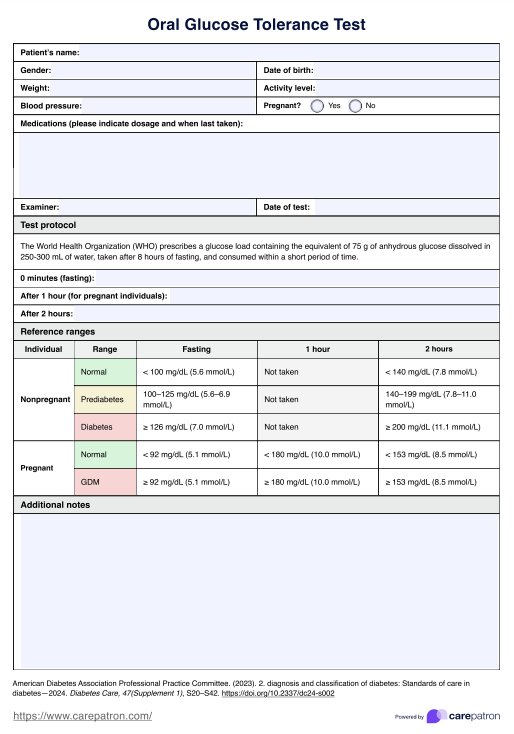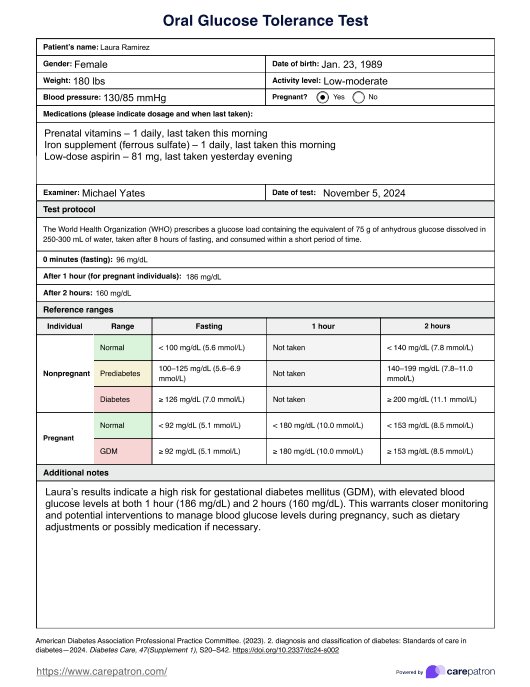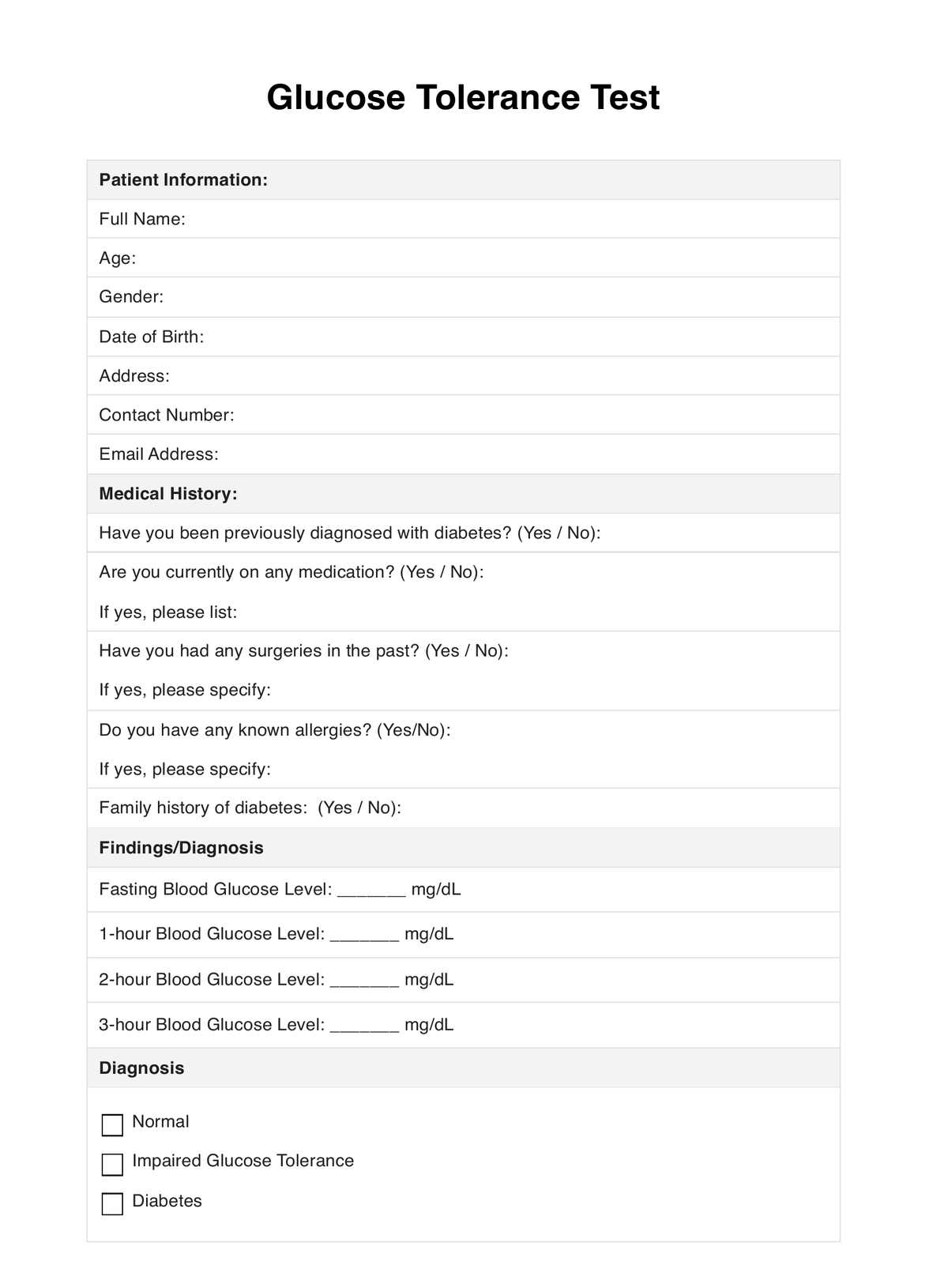Oral Glucose Tolerance
Understand the body's response to glucose with an Oral Glucose Tolerance Test, a diagnostic test for measuring blood sugar levels post-glucose intake.


What is an Oral Glucose Tolerance Test?
The Oral Glucose Tolerance Test (OGTT), also known as the 75g OGTT, two-hour glucose tolerance test, or simply glucose tolerance test, is a diagnostic procedure to assess how the body regulates sugar. It's commonly employed for evaluating diabetes or gestational diabetes. During the test, a patient typically fasts overnight and then drinks a solution containing a precise amount of glucose—75 grams, as prescribed by the World Health Organization (WHO). Blood samples are drawn right before drinking the solution and after two hours for nonpregnant individuals to measure blood glucose level, which indicates how the body processes the glucose over time. This is usually measured in millimoles of glucose per liter of blood (mmol/L).
This test helps determine how effectively the body processes sugar. High levels of glucose after the drink may suggest potential issues with insulin regulation or diabetes. It's crucial in identifying prediabetes or diabetes, which might otherwise go undetected. The OGTT is also used in pregnancy to diagnose gestational diabetes mellitus (GDM), a condition that can affect the health of both the mother and the baby; for pregnant individuals, the glucose level is measured before solution intake, at 1 hour and 2 hours.
Medical professionals use the results to evaluate a patient's blood sugar level and determine their body's response to the sugar load. Persistent high blood glucose levels can indicate chronic conditions such as diabetes mellitus, which may lead to long-term complications affecting various body systems. These complications include an increased risk of cardiovascular disease, neuropathy, and potential progression to digestive and kidney diseases. Early diagnosis and management through tests like the OGTT help mitigate these risks and support better overall health outcomes.
The test requires commitment; the WHO prescribes fasting for 8 hours before intake of the glucose solution. However, it provides valuable insights into the body's glucose management. It's an essential tool for understanding and managing diabetes and other related conditions, enabling individuals to take proactive steps toward better health.
Oral Glucose Tolerance Template
Oral Glucose Tolerance Example
How to use our Oral Glucose Tolerance Test template
Our Oral Glucose Tolerance Test template is a practical tool for documenting patient assessments. It includes reference values and fields for comprehensive recording.
Step 1: Access the template
Open the template by clicking the "Use template" button in the Carepatron app, which allows for customization, filling, and sharing. Alternatively, download a non-customizable PDF version by clicking the "Download" button for direct digital use or printing.
Step 2: Prepare and explain the procedure
Ensure the patient understands the test protocol, including the requirement for fasting blood glucose level measurements before drinking the glucose solution. Explain the importance of accurate timing and blood sample collection throughout the test.
Step 3: Administer the test and record findings
Follow the test procedure as outlined in the template, documenting the patient's initial fasting level and subsequent readings at designated intervals. This ensures data is accurately captured in the OGTT test report format.
Step 4: Interpret and discuss results
Compare the patient's blood glucose levels against the reference ranges in the template to identify normal, impaired, or diabetic responses. Discuss findings with the patient, emphasizing further confirmatory tests if hyperglycemia is not definitive. For example, a pregnant individual may undergo a glucose challenge test to confirm a diagnosis.
By following these steps, healthcare professionals can confidently conduct, document, and interpret OGTTs, ensuring comprehensive patient care.
What do the results mean?
Interpreting the results of glucose tolerance tests is essential for identifying a patient’s metabolic status. The Oral Glucose Tolerance Test compares blood glucose levels at different times to assess how well the body handles glucose. The values below are taken from the ADA's Standards of Care (2024):
Normal
Normal results suggest efficient glucose processing. In nonpregnant individuals, fasting plasma glucose should be below 100 mg/dL, and the two-hour glucose tolerance test value should remain under 140 mg/dL. Pregnant individuals should have fasting plasma glucose below 92 mg/dL, with one-hour levels below 180 mg/dL and two-hour levels below 153 mg/dL.
Prediabetes (impaired glucose tolerance)
Prediabetes is indicated when fasting blood glucose levels range from 100–125 mg/dL or two-hour post-glucose levels fall between 140–199 mg/dL. This status signals an increased risk of developing diabetes and potential metabolic disorders.
Diabetes diagnosis
A diabetes diagnosis is made if fasting blood glucose levels are 126 mg/dL or higher or two-hour plasma glucose readings reach or exceed 200 mg/dL. Persistent elevation of these levels requires prompt intervention to manage the condition and prevent complications.
Gestational diabetes mellitus diagnosis
Gestational diabetes is diagnosed in pregnant individuals using specific thresholds during the OGTT, which differ from nonpregnant standards. For a diagnosis, fasting blood glucose must be 92 mg/dL or higher, the one-hour reading should be 180 mg/dL or higher, and the two-hour value must be 153 mg/dL or higher. Unlike the typical two-hour test for nonpregnant individuals, pregnant individuals undergo a three-point test, where blood samples are taken before consuming the glucose solution, at one hour and two hours post-ingestion.
Hypoglycemia or reactive hypoglycemia
Rarely, the test may show abnormally low blood glucose levels post-ingestion, suggesting abnormal glucose tolerance, hypoglycemia, or reactive hypoglycemia. This can cause symptoms such as dizziness and shakiness.
When to do the Oral Glucose Tolerance Test
The Oral Glucose Tolerance Test is used in various medical contexts to evaluate how the body handles glucose intake. Below are common scenarios for administering the test:
- Diabetes diagnosis and management: Helps confirm or rule out diabetes when fasting blood glucose results are inconclusive.
- Gestational diabetes screening: Assesses blood sugar levels in pregnant individuals, typically between the 24th and 28th weeks.
- Endocrine and metabolic disorder investigation: Assists in diagnosing conditions like polycystic ovary syndrome (PCOS) or suspected hypoglycemia.
- Research and clinical studies: Used to analyze glucose metabolism and insulin resistance.
- Unexplained symptoms: Identifies abnormal glucose tolerance when patients present symptoms but have normal fasting glucose results.
References
American Diabetes Association Professional Practice Committee. (2023). 2. diagnosis and classification of diabetes: Standards of care in diabetes—2024. Diabetes Care, 47(Supplement 1), S20–S42. https://doi.org/10.2337/dc24-s002
Commonly asked questions
A normal Oral Glucose Tolerance Test (OGTT) result for nonpregnant individuals includes fasting blood glucose levels under 100 mg/dL and 2-hour post-glucose levels below 140 mg/dL. For pregnant individuals, normal ranges are fasting levels under 92 mg/dL, 1-hour levels below 180 mg/dL, and 2-hour levels below 153 mg/dL.
Reading Oral Glucose Tolerance Test (OGTT) results involves comparing measured blood glucose levels at fasting, 1-hour, and 2-hour post-glucose intake against standardized thresholds. Elevated plasma glucose values can indicate abnormal glucose tolerance, prediabetes, or diabetes. The actual OGTT test report format may vary depending on the laboratory's preferred report format.
The WHO-prescribed rules for a 2-hour Oral Glucose Tolerance Test (OGTT) require an 8-hour fasting period before the test, during which patients consume a 75g glucose solution. Blood samples are taken before ingestion and at set intervals to measure the body's plasma glucose response.












































































































